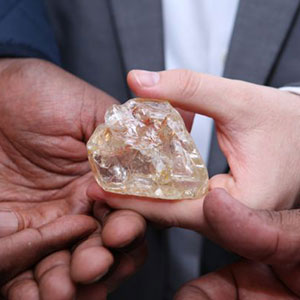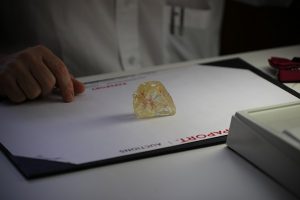
When a 709 ct. stone—the 14th-largest piece of rough ever discovered—was unearthed by diggers in Sierra Leone in March, the discovery filled the country with both pride and anxiety.
Sierra Leone is one of the poorest countries in the world. Most of the people involved in digging up diamonds do it on an informal basis and are paid less than one dollar a day. Smuggling is rampant. Critics say that the country has received only a fraction of the proceeds from its diamond industry.
But this diamond has turned into a source of national pride, with country president Ernest Bai Komora displaying it on TV and promising that the proceeds will aid the local economy.
So far that’s proven easier said than done. When the government tried to auction it off locally, bidding topped off at $7.7 million. The stone’s owner, a local pastor named Emmanuel Momoh, rejected the bid and the government pledged to try again. Analysts say this diamond has turned into a test case and a way for the Sierra Leone government to demonstrate to locals the benefits of selling stones through legal channels rather than just smuggling them.
Now the diamond has fallen into the hands of the Rapaport Corporation, which will auction it off Dec. 4. Its goal is to get what chairman Martin Rapaport describes as “fair market value” for the stone—which, one assumes, means more than $7 million.
Rapaport has long been active in Sierra Leone, due to his—still largely unsuccessful—bid to sell Fair Trade Diamonds from the country.
His vision for this stone, called the “Peace Diamond,” is very similar to his plan for Fair Trade gems: Stress the social benefits of the diamond, as much as the stone itself.

During a teleconference Tuesday, he rattled off statistics showing how proceeds will go to benefit the locals. He also admitted that the gem, while an undeniably impressive find, probably won’t turn into a perfect piece of polished: “Most diamond dealers don’t know what to do with this diamond,” he said. “It’s not just one diamond, it’s many diamonds…Maybe it’s not a D, maybe it’s an H.”
But the stone’s virtues go well beyond that, he argued.
“This isn’t just another diamond,” he said. “This is a diamond that benefits the people of Sierra Leone. Imagine all this money coming into Sierra Leone, into bridges and roads and schools, instead of disappearing into the black markets.
“This is an awesomely powerful marketing concept,” he said. “You can’t do a bigger mitzvah than buying this diamond.”
Of course, once it is cut, the seller may choose to sell it like, as Rapaport put it, just another diamond. But Rapaport, who was unavailable for further comment, is clearly hopeful it will be sold as something more.
“This is the beginning of a whole new approach to diamond marketing,” he said. “You don’t just sell diamonds, you sell the idea behind the diamond. And there is no more beautiful idea than the one behind this diamond. This diamond really helps people. It makes the world a better place.”
(Photo courtesy of Rapaport Corporation)
- Subscribe to the JCK News Daily
- Subscribe to the JCK Special Report
- Follow JCK on Instagram: @jckmagazine
- Follow JCK on X: @jckmagazine
- Follow JCK on Facebook: @jckmagazine